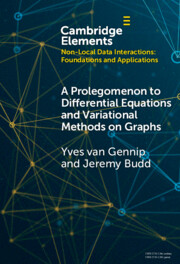Refine search
Actions for selected content:
2540 results in Computational Science
8 - Dependence
- from Part II - Foundations of Probabilistic Modeling
-
- Book:
- Probabilistic Data-Driven Modeling
- Published online:
- 17 May 2025
- Print publication:
- 01 May 2025, pp 113-140
-
- Chapter
- Export citation
3 - Fundamentals of Machine Learning
- from Part I - Preliminaries
-
- Book:
- Probabilistic Data-Driven Modeling
- Published online:
- 17 May 2025
- Print publication:
- 01 May 2025, pp 21-32
-
- Chapter
- Export citation
Frontmatter
-
- Book:
- Probabilistic Data-Driven Modeling
- Published online:
- 17 May 2025
- Print publication:
- 01 May 2025, pp i-iv
-
- Chapter
- Export citation
Part III - Model Construction from Data
-
- Book:
- Probabilistic Data-Driven Modeling
- Published online:
- 17 May 2025
- Print publication:
- 01 May 2025, pp 219-220
-
- Chapter
- Export citation
14 - Parametric Estimation of Univariate Probabilities from Data
- from Part III - Model Construction from Data
-
- Book:
- Probabilistic Data-Driven Modeling
- Published online:
- 17 May 2025
- Print publication:
- 01 May 2025, pp 241-266
-
- Chapter
- Export citation
15 - Estimation of Multivariate Probabilities from Data
- from Part III - Model Construction from Data
-
- Book:
- Probabilistic Data-Driven Modeling
- Published online:
- 17 May 2025
- Print publication:
- 01 May 2025, pp 267-300
-
- Chapter
- Export citation
Appendix E - Random Forest
-
- Book:
- Probabilistic Data-Driven Modeling
- Published online:
- 17 May 2025
- Print publication:
- 01 May 2025, pp 408-409
-
- Chapter
- Export citation
2 - Fundamentals of Probability
- from Part I - Preliminaries
-
- Book:
- Probabilistic Data-Driven Modeling
- Published online:
- 17 May 2025
- Print publication:
- 01 May 2025, pp 9-20
-
- Chapter
- Export citation
1 - Introduction
- from Part I - Preliminaries
-
- Book:
- Probabilistic Data-Driven Modeling
- Published online:
- 17 May 2025
- Print publication:
- 01 May 2025, pp 3-8
-
- Chapter
-
- You have access
- Export citation

A Prolegomenon to Differential Equations and Variational Methods on Graphs
-
- Published online:
- 05 February 2025
- Print publication:
- 27 February 2025
-
- Element
-
- You have access
- Open access
- HTML
- Export citation
4 - Global Schemes for Fractional PDEs (FPDEs)
-
- Book:
- Spectral and Spectral Element Methods for Fractional Ordinary and Partial Differential Equations
- Published online:
- 31 October 2024
- Print publication:
- 14 November 2024, pp 290-443
-
- Chapter
- Export citation
8 - Applications of Anomalous Transport and Fractional Modeling
-
- Book:
- Spectral and Spectral Element Methods for Fractional Ordinary and Partial Differential Equations
- Published online:
- 31 October 2024
- Print publication:
- 14 November 2024, pp 653-689
-
- Chapter
- Export citation
1 - Fractional Calculus and Anomalous Transport
-
- Book:
- Spectral and Spectral Element Methods for Fractional Ordinary and Partial Differential Equations
- Published online:
- 31 October 2024
- Print publication:
- 14 November 2024, pp 1-36
-
- Chapter
- Export citation
3 - Global Schemes for Fractional ODEs (FODEs)
-
- Book:
- Spectral and Spectral Element Methods for Fractional Ordinary and Partial Differential Equations
- Published online:
- 31 October 2024
- Print publication:
- 14 November 2024, pp 122-289
-
- Chapter
- Export citation
Contents
-
- Book:
- Spectral and Spectral Element Methods for Fractional Ordinary and Partial Differential Equations
- Published online:
- 31 October 2024
- Print publication:
- 14 November 2024, pp ix-x
-
- Chapter
- Export citation
2 - Spectral Expansions and Related Approximations
-
- Book:
- Spectral and Spectral Element Methods for Fractional Ordinary and Partial Differential Equations
- Published online:
- 31 October 2024
- Print publication:
- 14 November 2024, pp 37-121
-
- Chapter
- Export citation
Preface
-
- Book:
- Spectral and Spectral Element Methods for Fractional Ordinary and Partial Differential Equations
- Published online:
- 31 October 2024
- Print publication:
- 14 November 2024, pp xi-xiii
-
- Chapter
- Export citation
Acknowledgments
-
- Book:
- Spectral and Spectral Element Methods for Fractional Ordinary and Partial Differential Equations
- Published online:
- 31 October 2024
- Print publication:
- 14 November 2024, pp xiv-xiv
-
- Chapter
- Export citation
References
-
- Book:
- Spectral and Spectral Element Methods for Fractional Ordinary and Partial Differential Equations
- Published online:
- 31 October 2024
- Print publication:
- 14 November 2024, pp 690-719
-
- Chapter
- Export citation
Dedication
-
- Book:
- Spectral and Spectral Element Methods for Fractional Ordinary and Partial Differential Equations
- Published online:
- 31 October 2024
- Print publication:
- 14 November 2024, pp vii-viii
-
- Chapter
- Export citation
